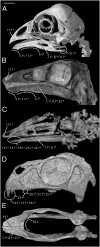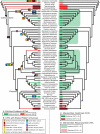Herbivorous ecomorphology and specialization patterns in theropod dinosaur evolution - PubMed (original) (raw)
Herbivorous ecomorphology and specialization patterns in theropod dinosaur evolution
Lindsay E Zanno et al. Proc Natl Acad Sci U S A. 2011.
Abstract
Interpreting key ecological parameters, such as diet, of extinct organisms without the benefit of direct observation or explicit fossil evidence poses a formidable challenge for paleobiological studies. To date, dietary categorizations of extinct taxa are largely generated by means of modern analogs; however, for many species the method is subject to considerable ambiguity. Here we present a refined approach for assessing trophic habits in fossil taxa and apply the method to coelurosaurian dinosaurs--a clade for which diet is particularly controversial. Our findings detect 21 morphological features that exhibit statistically significant correlations with extrinsic fossil evidence of coelurosaurian herbivory, such as stomach contents and a gastric mill. These traits represent quantitative, extrinsically founded proxies for identifying herbivorous ecomorphology in fossils and are robust despite uncertainty in phylogenetic relationships among major coelurosaurian subclades. The distribution of these features suggests that herbivory was widespread among coelurosaurians, with six major subclades displaying morphological evidence of the diet, and that contrary to previous thought, hypercarnivory was relatively rare and potentially secondarily derived. Given the potential for repeated, independent evolution of herbivory in Coelurosauria, we also test for repetitive patterns in the appearance of herbivorous traits within sublineages using rank concordance analysis. We find evidence for a common succession of increasing specialization to herbivory in the subclades Ornithomimosauria and Oviraptorosauria, perhaps underlain by intrinsic functional and/or developmental constraints, as well as evidence indicating that the early evolution of a beak in coelurosaurians correlates with an herbivorous diet.
Conflict of interest statement
The authors declare no conflict of interest.
Figures
Fig. 1.
Select cranial traits appearing in multiple lineages of coelurosaurian theropod dinosaurs tested herein as PHTs. Ecomorphological indicators statistically correlated with extrinsic evidence of herbivory (first- and second-order CHTs) are marked with an asterisk. Traits featured on six species representing four coelurosaurian theropod subclades, including the only predominantly folivorous modern bird. (A) Opisthocomus hoazin skull, left lateral view (extant Aves), adapted from
. Extinct theropods: (B) Ornithomimus edmontonicus (RTMP 95.110.1) skull, left lateral view (derived Ornithomimosauria); (C) Shenzhousaurus orientalis (NGMC 977–4-002) skull, left oblique dorsolateral view (primitive Ornithomimosauria), adapted from ref. ; (D) Incisivosaurus gauthieri (IVPP V13326) skull left lateral view (primitive Oviraptorosauria); and (E) Caenagnathus collinsi (CMN 8776) fused lower mandibles, dorsal view (derived Oviraptorosauria;
Table S7
, and see
SI Appendix, Section A3
for trait descriptions.
Fig. 2.
Phylogeny of coelurosaurian theropods used in correlation and correspondence analyses showing: (A) Distribution of EEH and EEC (Left; for explanation, see
Table S1
); (B) Ancestral state reconstruction optimizations using maximum parsimony (ASR-MP) of the 11 CHTs detected as evolving in a statistically significant order in the clades Ornithomimosauria and Oviraptorosauria (Left); and (C and D) Quantitative dietary interpretations at the species level based on the total number of actual CHTs (C Right) and interpretations estimated using ASR-MP (D Right), respectively (
Table S3
). Black bars on phylogeny at right represent taxa with intermediate numbers of CHTs for which diet is ambiguous. Only ancestral (not autapomorphic) optimizations were used for rank correspondence analysis although both are shown here. For alternate tree topologies used in analyses, see
Fig. S1
. Species collapsed into higher-level OTUs for Dromaeosauridae, Compsognathidae, and Tyrannosauroidea. Black/red stripe indicates that some species in higher-level OTUs possess evidence of diet. Actual CHT number ≤1 for all dromaeosaurs except Microraptor. Reconstructed CHT number ≤3 for all dromaeosaurs except Rahonavis, Buitreraptor, and Unenlagia. For specific data on CHT number per species, see
Table S3
. See
SI Appendix, Section A3
for genus abbreviations.
Similar articles
- No evidence for directional evolution of body mass in herbivorous theropod dinosaurs.
Zanno LE, Makovicky PJ. Zanno LE, et al. Proc Biol Sci. 2013 Jan 22;280(1751):20122526. doi: 10.1098/rspb.2012.2526. Proc Biol Sci. 2013. PMID: 23193135 Free PMC article. - A new North American therizinosaurid and the role of herbivory in 'predatory' dinosaur evolution.
Zanno LE, Gillette DD, Albright LB, Titus AL. Zanno LE, et al. Proc Biol Sci. 2009 Oct 7;276(1672):3505-11. doi: 10.1098/rspb.2009.1029. Epub 2009 Jul 15. Proc Biol Sci. 2009. PMID: 19605396 Free PMC article. - Repeated Evolution of Divergent Modes of Herbivory in Non-avian Dinosaurs.
Button DJ, Zanno LE. Button DJ, et al. Curr Biol. 2020 Jan 6;30(1):158-168.e4. doi: 10.1016/j.cub.2019.10.050. Epub 2019 Dec 5. Curr Biol. 2020. PMID: 31813611 - Testing co-evolutionary hypotheses over geological timescales: interactions between Mesozoic non-avian dinosaurs and cycads.
Butler RJ, Barrett PM, Kenrick P, Penn MG. Butler RJ, et al. Biol Rev Camb Philos Soc. 2009 Feb;84(1):73-89. doi: 10.1111/j.1469-185X.2008.00065.x. Epub 2008 Dec 19. Biol Rev Camb Philos Soc. 2009. PMID: 19133960 Review. - From extant to extinct: locomotor ontogeny and the evolution of avian flight.
Heers AM, Dial KP. Heers AM, et al. Trends Ecol Evol. 2012 May;27(5):296-305. doi: 10.1016/j.tree.2011.12.003. Epub 2012 Feb 1. Trends Ecol Evol. 2012. PMID: 22304966 Review.
Cited by
- A fast-growing basal troodontid (Dinosauria: Theropoda) from the latest Cretaceous of Europe.
Sellés AG, Vila B, Brusatte SL, Currie PJ, Galobart À. Sellés AG, et al. Sci Rep. 2021 Mar 1;11(1):4855. doi: 10.1038/s41598-021-83745-5. Sci Rep. 2021. PMID: 33649418 Free PMC article. - Martharaptor greenriverensis, a new theropod dinosaur from the Lower Cretaceous of Utah.
Senter P, Kirkland JI, DeBlieux DD. Senter P, et al. PLoS One. 2012;7(8):e43911. doi: 10.1371/journal.pone.0043911. Epub 2012 Aug 29. PLoS One. 2012. PMID: 22952806 Free PMC article. - Evolutionary versatility of the avian neck.
Marek RD, Falkingham PL, Benson RBJ, Gardiner JD, Maddox TW, Bates KT. Marek RD, et al. Proc Biol Sci. 2021 Mar 10;288(1946):20203150. doi: 10.1098/rspb.2020.3150. Epub 2021 Mar 3. Proc Biol Sci. 2021. PMID: 33653136 Free PMC article. - Dental form and function in the early feeding diversification of dinosaurs.
Ballell A, Benton MJ, Rayfield EJ. Ballell A, et al. Sci Adv. 2022 Dec 16;8(50):eabq5201. doi: 10.1126/sciadv.abq5201. Epub 2022 Dec 16. Sci Adv. 2022. PMID: 36525501 Free PMC article. - Identification of avian flapping motion from non-volant winged dinosaurs based on modal effective mass analysis.
Talori YS, Zhao JS, Liu YF, Lu WX, Li ZH, O'Connor JK. Talori YS, et al. PLoS Comput Biol. 2019 May 2;15(5):e1006846. doi: 10.1371/journal.pcbi.1006846. eCollection 2019 May. PLoS Comput Biol. 2019. PMID: 31048911 Free PMC article.
References
- Weishampel DB, Norman DB. In: Paleobiology of the Dinosaurs. Farlow JO, editor. Boulder, CO: Geol Soc Am; 1989. pp. 87–100.
- Barrett PM, Willis KJ. Did dinosaurs invent flowers? Dinosaur-angiosperm coevolution revisited. Biol Rev Camb Philos Soc. 2001;76:411–447. - PubMed
- Farlow JO. Speculations about the diet and digestive physiology of herbivorous dinosaurs. Paleobiology. 1987;13:60–72.
- Benton MJ. Dinosaur success in the Triassic: A noncompetitive ecological model. Q Rev Biol. 1983;58:29–55.
- Brusatte SL, Benton MJ, Ruta M, Lloyd GT. Superiority, competition, and opportunism in the evolutionary radiation of dinosaurs. Science. 2008;321:1485–1488. - PubMed
Publication types
MeSH terms
LinkOut - more resources
Full Text Sources

